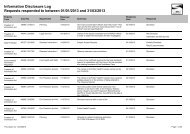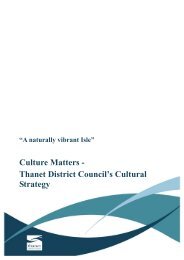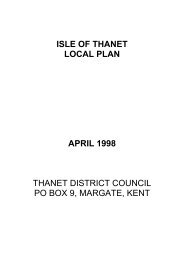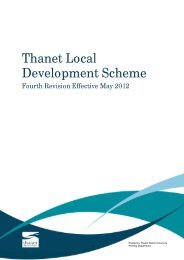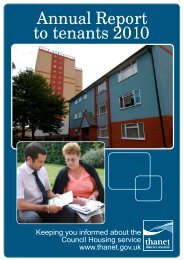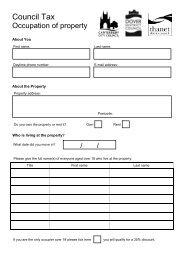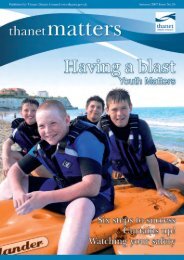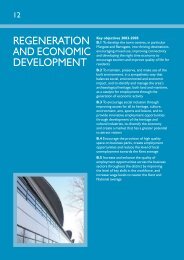Review of existing Section 106 Agreement - Thanet District Council
Review of existing Section 106 Agreement - Thanet District Council
Review of existing Section 106 Agreement - Thanet District Council
Create successful ePaper yourself
Turn your PDF publications into a flip-book with our unique Google optimized e-Paper software.
In respect <strong>of</strong> noise mitigation measures, there are currently three airportsdesignated under <strong>Section</strong> 80 <strong>of</strong> Civil Aviation Act 1982 for the purposes <strong>of</strong><strong>Section</strong> 78 <strong>of</strong> that Act – Heathrow, Gatwick and Stansted. <strong>Section</strong> 78empowers the Secretary <strong>of</strong> State to regulate noise and vibration connectedwith aircraft taking <strong>of</strong>f or landing at these “designated airports”. The origins <strong>of</strong>this arrangement date back to the 1960’s, when these airports were part <strong>of</strong> thenational British Airports Authority, where at that time these provided thepredominant proportion <strong>of</strong> air services from the entire UK. Development andmanagement <strong>of</strong> noise monitoring and noise insulation compensation schemeswere carried by the then Department <strong>of</strong> Transport, not the airports operator.The introduction <strong>of</strong> common arrangements introduced at the designatedairports in the early 1990’s resulted in the same system <strong>of</strong> aircraftclassification for aircraft at any <strong>of</strong> these airports, with restrictions on commonrules, including the same hours <strong>of</strong> restrictions, and the same rules fordispensations, early arrivals and administration. The only difference is thatmovement and night quotas are set separately at each airport, to reflectspecific market differences in the air services operated.At all other UK airports – “non-designated” in <strong>Section</strong> 78 and 80 noiselegislation terms – the impact <strong>of</strong> noise can only be controlled by operationalrestrictions imposed by the planning system and the goodwill <strong>of</strong> the airportoperators. The airline industry itself is protected from any legal action inrespect <strong>of</strong> nuisance by virtue <strong>of</strong> the Air Navigation Order 1920.However, in practice, the control <strong>of</strong> noise at other airports has been achievedby means <strong>of</strong> the planning process. In particular, by using the custom andpractice <strong>of</strong> procedures and standards at the Designated Airports asbenchmarks to judge the value and effectiveness <strong>of</strong> operational controls,facilities and procedures aimed at mitigating environmental and noise impact.The standards and principles set for the Designated Airports, and Governmentactions to regulate these for environmental objectives, has set the frameworkfor the introduction <strong>of</strong> comparable measures at other UK airports. The keyissue for consideration is the need to examine any proposed measure derivedfrom the examples at Designated Airports in context <strong>of</strong> that airport’s actuallevel <strong>of</strong> activity, <strong>existing</strong> or planned, and the commercial and investmentresources that are realistically likely to be available to implement anymeasure.Licensed airports have the power, under <strong>Section</strong> 38 <strong>of</strong> the 1982 Act to fix theircharges in relation to aircraft noise, or to the inconvenience resulting fromsuch noise, including departures from compliance to noise routingrequirements in the vicinity <strong>of</strong> the airport.<strong>Section</strong> 35 <strong>of</strong> the 1982 Act originally set up formal Consultative Committeesfor Heathrow and Gatwick. Many other airports subsequently set upconsultative committees to parallel the requirements <strong>of</strong> <strong>Section</strong> 35 <strong>of</strong> the Act,although only those airports actually designated by the Secretary <strong>of</strong> State forTransport are obliged to provide such facilities. With the number <strong>of</strong> otherairports that operated Committees <strong>of</strong> some form on a “goodwill basis”,revisions to the process were made in 1987. The DfT Guidance Note forEU00142:FINAL REPORT PAGE 4



